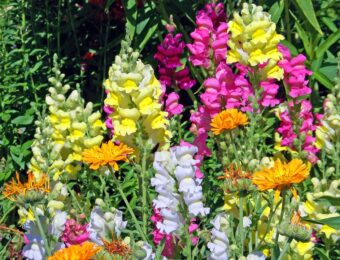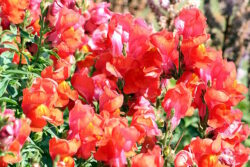In this article, we will discuss how to grow the short-lived perennials of Antirrhinums in containers. They are wonderful colourful plants that have the common name of Snapdragons. It is a firm favourite, old-fashioned cottage plant that is loved by insects. There are so many varieties all having different colours under the rainbow and growing heights.

Although they are short-lived perennials, they are treated as annuals because they tend to suffer from diseases that make the plant unattractive the next growing season. Anybody who has snapdragons in the garden will tell you that they are prolific self-seeders and you will get volunteers appearing everywhere.
They are easy to grow as you will soon see. Antirrhinums has come a long way from those grown many years ago with more compact varieties continuing to be developed. These dwarf varieties and strains have made this plant more suitable for growing in containers.
Trailing varieties also exist that are suitable to be grown in hanging baskets or window boxes. You can grow then as a sole specimen as a mix coloured display in reds, yellows, oranges, whites and even two bicolour varieties. You can also as an alternative grow them mixed with other bedding plants such as Pelargoniums, Verbena and Petunias.
GROWING ANTIRRHINUMS IN CONTAINERS
You have two choices as you can buy garden-ready plants to fill your container display or you can rear from seed either planted in autumn or early spring in a greenhouse or on a sunny windowsill.
GROWING FROM SEED
First, fill a seed tray with seed compost and then water well. Sow the seeds thinly on the surface of the compost and then lightly sieve compost on top of them to cover the seeds. This should be started 6 weeks before the last frost date or in autumn where they can be overwintered in a greenhouse. Place a propagation lid on top of the seed tray and then place them on a sunny windowsill, where it will germinate.
Once the seedlings are large enough, you can transplant them into 15-cell packs full of multipurpose compost to allow the plant to develop further. They can be moved either to a sheltered spot in the garden or in a cold frame.
Once the danger of frosts has passed in May, you can harden the plants off and then plant them in their final location.
GROWING IN CONTAINERS

At this stage, you can plant your seed sown plants and shop-bought plants in the same way.
First, get a container that has plenty of drainage holes at the bottom. Fill it with a good quality multipurpose compost and dig a hole in it that is slightly larger than the root ball it came in the original container.
When planting makes sure the root ball is at the same level as the top of the root ball it came inside the original container. Backfill with the growing media, making sure that any gaps that remain are filled with more compost, Firm it in and water well allowing the compost to settle.
As the plant is often treated as an annual, it is not worth feeding them with a slow-release fertilizer. It is better to feed every week whilst in flower with a high potash fertilizer like a tomato feed at the manufacturer’s recommendation. You will also need to deadhead regularly to ensure that new blooms are continually produced.
Snapdragons prefer it on the drier side, so you only have to water when 5cm below the top surface of the compost feels dry to the touch. You may need to water frequently in dry spells.
Grow it in a location where it gets the most sunlight possible- a south-facing location is ideal.
PESTS AND DISEASES
Thankfully the rust once suffered by these plants has been eliminated as so many rust-resistant varieties have been bred. They do not really suffer from any pests or diseases and as a result, this makes them great ideal container plants.
VARIETIES TO GROW

Most of the varieties you are likely to find and buy are based on Antirrhinum majus that comes in so many colours from white, yellow, orange, pink, purple, red and are often multi-coloured as well.
You can grow the pink and red ‘Lucky Lips’, the white ‘Royal Bride’ and the red-leaved and pink-flowered ‘Bronze Dragon’. You can buy various coloured mixes such as ‘Magic Carpet’, ‘Circus Clowns’, ‘Double Madame Butterfly Mix’, ‘Dwarf Bedding Mix’ or ‘Reminiscent Mix’.
For trailing in hanging baskets, you can grow ‘Antirrhinum Trailing’ or ‘Chinese Lanterns’. For mixed colours, you can grow the purple and pink-flowered ‘Purple Twist’ or the red and orange colour ‘Rembrandt’.
A wonderful species that is a little bit different, where you can grow yellow and white flowers, is Antirrhinum braun-blanquetii.
CONCLUSIONS
In this article, we have discussed how to grow antirrhinums in containers. As you can see you have such a wide choice of varieties to grow and it is so easy to grow from seeds, as they come in so many available mixes. They are so easy to grow, easy to look after and you will have colour all summer long. This is provided you deadhead, water and feed regularly. A plant that should brace any summer bedding plant container scheme.
If you have any questions or comments that you wish to make on growing Antirrhinums in containers, please do so in the comment box below.
Happy Antirrhinum growing.
